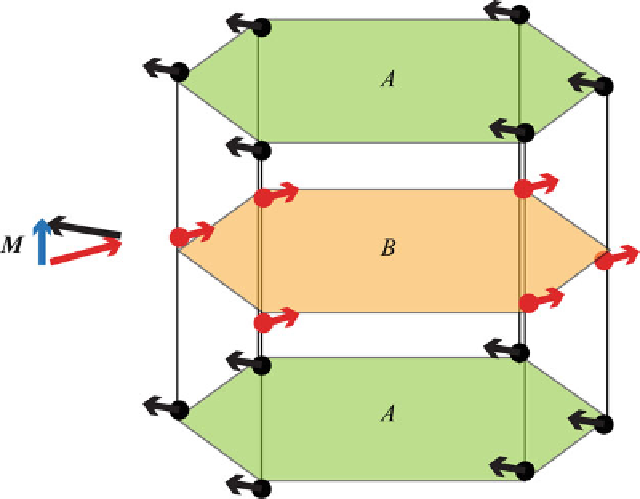Geology Reference
In-Depth Information
Fig. 3.19
Canted
antiferromagnetic
arrangement of Fe
3C
spins
unit cells of hematite.
Red
and
black circles
are Fe
3C
ions with opposite
magnetic moments. Note
that the ions are displaced
upward or downward along
the
c
-axis of the crystal.
Red
and
black arrows
indicate spin directions.
The resulting net
magnetization is
represented by the
blue
arrow
The
natural remnant magnetization
(NRM) of
a rock is the remanent magnetization
M
r
that
can be measured on a rock specimen through a
laboratory magnetometer. The magnitude and di-
rection of this vector depend from the geographic
location of the rock at the time of its forma-
tion and eventually from subsequent geological
processes. The original NRM acquired during
the process of formation of the rock is referred
to as the
primary
NRM. Any successive com-
ponent that contributes to the observed remnant
magnetization is called a
secondary
component.
Thus,
Fig. 3.20
Magnetic susceptibility per unit mass,
¦
,vs.
temperature (
ı
C) for a sample of hematite (Fe
2
O
3
) (Mod-
ified from de Boer et al.
2001
)
M
r
D
M
primary
C
M
secondary
(3.79)
There are three basic kinds of primary NRM.
They are:
by a different number of atoms. The result is
a net spontaneous magnetization, which may be
of relevant magnitude. In the case of magnetite,
the spinel crystal structure of this mineral yields
a preferred direction of magnetization along the
cube diagonal [111]. Other examples of ferrimag-
netic minerals are titanohematites, Fe
2
x
Ti
x
O
3
,
when
x
> 0.45, whereas for 0<
x
<0.45 these
substances conserve the canted antiferromagnetic
arrangement of hematite.
Thermoremanent
magnetization
(TRM),
which
is
acquired
during
cooling
from
temperatures above the
Curie
temperature.
This
is
the
typical
form
of
remanent
magnetization of igneous rocks;
Chemical remanent magnetization
(CRM),
which forms by growth of ferromagnetic
grains below the Curie temperature and is
the typical kind of remanent magnetization in
sedimentary rocks. It results from chemical


